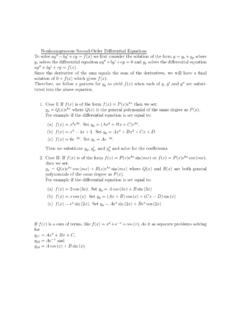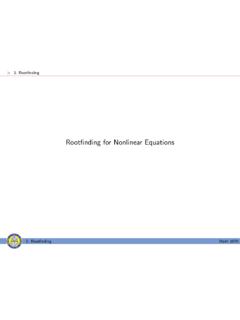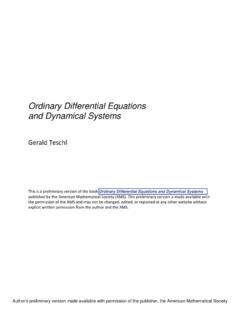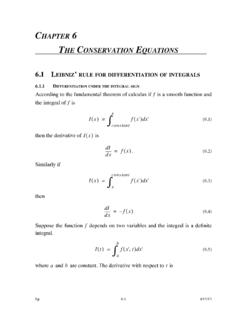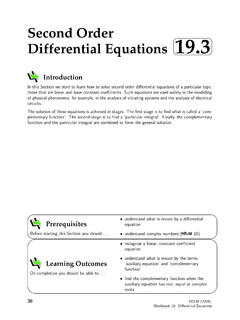Transcription of APPLICATIONS OF SECOND-ORDER DIFFERENTIAL …
1 APPLICATIONS OF SECOND-ORDER DIFFERENTIAL EQUATIONSS econd- order linear DIFFERENTIAL equations have a variety of APPLICATIONS in science andengineering. In this section we explore two of them: the vibration of springs and SPRINGSWe consider the motion of an object with mass at the end of a spring that is either ver-tical (as in Figure 1) or horizontal on a level surface (as in Figure 2).In Section we discussed Hooke s Law, which says that if the spring is stretched (orcompressed) units from its natural length, then it exerts a force that is proportional to :where is a positive constant (called the spring constant).
2 If we ignore any external resist-ing forces (due to air resistance or friction) then, by Newton s second Law (force equalsmass times acceleration), we haveThis is a SECOND-ORDER linear DIFFERENTIAL equation. Its auxiliary equation is with roots , where . Thus, the general solution iswhich can also be written aswhere(frequency)(amplitude)(See Exercise 17.) This type of motion is called simple harmonic 1A spring with a mass of 2 kg has natural length m. A force of N isrequired to maintain it stretched to a length of m. If the spring is stretched to a lengthof m and then released with initial velocity 0, find the position of the mass at anytime.
3 SOLUTIONFrom Hooke s Law, the force required to stretch the spring isso . Using this value of the spring constant , together with in Equation 1, we haveAs in the earlier general discussion, the solution of this equation isx t c1 cos 8t c2 sin 8t22 d2xdt2 128x 0m 2kk 128k is the phase angle sin c2 Acos c1A A sc12 c22 sk mx t Acos t x t c1cos t c2sin t sk mr imr2 k 0m d2xdt2 kx 0orm d2xdt2 kx1krestoring force kxxxm1 FIGURE 2 FIGURE 1x0xequilibrium positionmmx0xmequilibriumpositionThomson Brooks-Cole copyright 2007We are given the initial condition that.
4 But, from Equation 2,Therefore,. Differentiating Equation 2, we getSince the initial velocity is given as , we have and so the solution isDAMPED VIBRATIONSWe next consider the motion of a spring that is subject to a frictional force (in the case ofthe horizontal spring of Figure 2) or a damping force (in the case where a vertical springmoves through a fluid as in Figure 3). An example is the damping force supplied by ashock absorber in a car or a assume that the damping force is proportional to the velocity of the mass and actsin the direction opposite to the motion.
5 (This has been confirmed, at least approximately,by some physical experiments.) Thuswhere is a positive constant, called the damping constant. Thus, in this case, Newton sSecond Law givesorEquation 3 is a SECOND-ORDER linear DIFFERENTIAL equation and its auxiliary equation is. The roots areWe need to discuss three I (overdamping)In this case and are distinct real roots andSince , , and are all positive, we have , so the roots and given byEquations 4 must both be negative. This shows that as . Typical graphs of as a function of are shown in Figure 4.
6 Notice that oscillations do not occur. (It s pos-sible for the mass to pass through the equilibrium position once, but only once.) This isbecause means that there is a strong damping force (high-viscosity oil or grease)compared with a weak spring or small II (critical damping)This case corresponds to equal rootsr1 r2 c2mc2 4mk 0c2 4mktxtl xl0r2r1sc2 4mk ckmcx c1er1t c2er2tr2r1c2 4mk 0r2 c sc2 4mk2mr1 c sc2 4mk2m4mr2 cr k 0m d2xdt2 c dxdt kx 03m d2xdt2 restoring force damping force kx c dxdtcdamping force c dxdtx t 15 cos 8tc2 0x 0 0x t 8c1sin 8t 8c2cos 8tc1 0 0 APPLICATIONS OF SECOND-ORDER DIFFERENTIAL EQUATIONSFIGURE 3mFIGURE 4 Overdampingxt0xt0 Schwinn Cycling and FitnessThomson Brooks-Cole copyright 2007 APPLICATIONS OF SECOND-ORDER DIFFERENTIAL EQUATIONS 3and the solution is given byIt is similar to Case I.
7 And typical graphs resemble those in Figure 4 (see Exercise 12), butthe damping is just sufficient to suppress vibrations. Any decrease in the viscosity of thefluid leads to the vibrations of the following III (underdamping)Here the roots are complex:whereThe solution is given byWe see that there are oscillations that are damped by the factor . Since and, implies thatasthat is, the motion decays to 0 as time increases. A typical graph is shown in Figure 2 Suppose that the spring of Example 1 is immersed in a fluid with dampingconstant . Find the position of the mass at any time if it starts from the equili-brium position and is given a push to start it with an initial velocity of m Example 1 the mass is and the spring constant is , so thedifferential equation (3) becomesorThe auxiliary equation is with roots and , so the motion is overdamped and the solution isWe are given that , so.
8 Differentiating, we getsoSince , this gives or . Thereforex e 4t e 16t c1 c1 x 0 4c1 16c2 x t 4c1e 4t 16c2e 16tc1 c2 0x 0 0x t c1e 4t c2e 16t 16 4r2 20r 64 r 4 r 16 0 d2xdt2 20 dxdt 64x 0 2 d2xdt2 40 dxdt 128x 0k 128m 40tl ;xl0tl e c 2m tl0 c 2m 0m 0c 0e c 2m tx e c 2m t c1cos t c2sin t s4mk c22mr1r2 c2m ic2 4mk 0x c1 c2t e c 2m tFIGURE 5 Underdampingxt0x=Ae (c/2m)tx=_Ae (c/2m)t Figure 6 shows the graph of the positionfunction for the overdamped motion in Example Brooks-Cole copyright 20074 APPLICATIONS OF SECOND-ORDER DIFFERENTIAL EQUATIONSFORCED VIBRATIONSS uppose that, in addition to the restoring force and the damping force, the motion of thespring is affected by an external force.
9 Then Newton s second Law givesThus, instead of the homogeneous equation (3), the motion of the spring is now governedby the following nonhomogeneous DIFFERENTIAL equation:The motion of the spring can be determined by the methods of Additional Topics: Nonho-mogeneous Linear commonly occurring type of external force is a periodic force functionIn this case, and in the absence of a damping force (), you are asked in Exercise 9 touse the method of undetermined coefficients to show thatIf , then the applied frequency reinforces the natural frequency and the result isvibrations of large amplitude.
10 This is the phenomenon of resonance(see Exercise 10).ELECTRIC CIRCUITSIn Additional Topics: Linear DIFFERENTIAL Equationswe were able to use first- order linearequations to analyze electric circuits that contain a resistor and inductor. Now that we know how to solve SECOND-ORDER linear equations, we are in a position to analyze thecircuit shown in Figure 7. It contains an electromotive force (supplied by a battery orgenerator), a resistor , an inductor , and a capacitor , in series. If the charge on thecapacitor at time is , then the current is the rate of change of with respect to.
